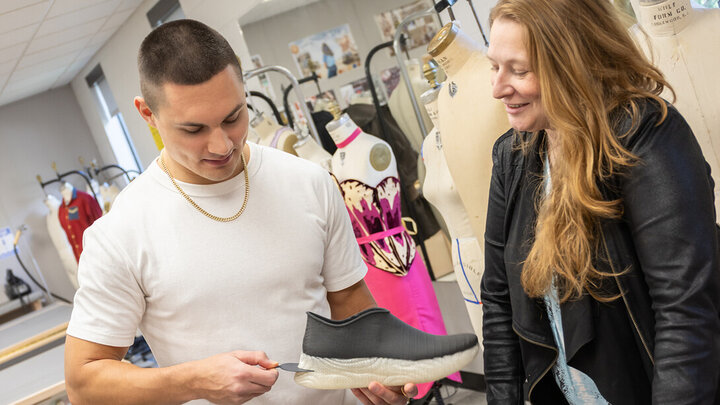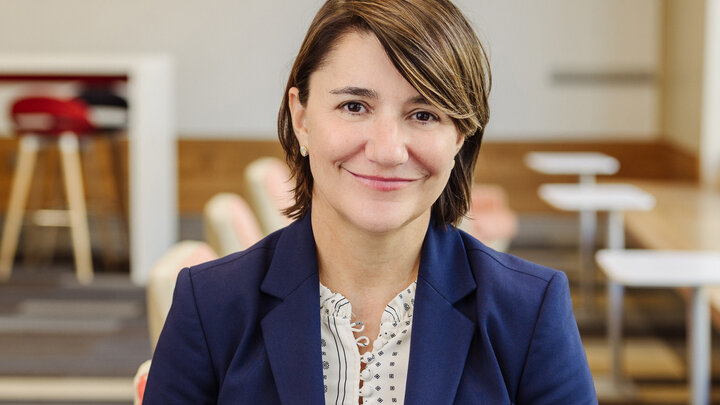As a College of Architecture graduate, Alex Gordon Stotz found parallels between his studies and a deep-rooted passion for set design and art direction. What began as curiosity sparked a successful career working on sets such as “Barbie,” “The Lord of the Rings: The Rings of Power” and many more.
The University Communication and Marketing team sat down with Gordon Stotz to ask him about his career, how lessons learned at Nebraska U have helped him, and what his advice is for Huskers who want to be a part of the film industry.
You are an accomplished art director and set designer. Talk a bit about your work and how you discovered a passion for art direction and design.
The job of set design or art direction itself is just one piece of a huge team of people that make the whole project come together. The art department also includes the production designer, graphic designers, assistant art directors, concept artists, art department coordinators, model makers and art department assistants. The art department is also very closely tied to props, set decoration and costumes. We all work in tandem with the visuals of the film.
The discovery and passion are constantly being reignited by new opportunities. Originally, while at UNL, just learning what set design and art direction were and how closely they related to my architecture major was enough to spark my interest. The architectural background, both in school and professionally, prepared me for this field and that easy adjustment and finding that I might actually be proficient in this career helps keep the passion strong.
Who or what inspired your career in film and television?
Whenever I am asked this, I usually go back to watching behind-the-scenes footage of “The Lord of the Rings”. There were moments when watching this where I very much recall thinking that the people making these movies are absolutely brilliant, but also just regular people. It really made this far-off world of moviemaking seem much more obtainable.
As I started exploring the field more, I also began consuming more movies. In doing this, I realized that I love the emotional experience of a film. Leaving a theater feeling exhausted from nonstop action, or with sore hands from gripping the armrest during a thriller or emotionally drained from crying at a drama are all things that I had only experienced with movies and television. I enjoy those experiences and am motivated to be a part of bringing them to other people.
Prior to working in art direction and set design, you were an architect in Washington, D.C. Can you talk about the transition from architecture to the film and television industry?
While I was in D.C., I did quite a bit of homework on what the tv and film industry is and what jobs I was going to be looking for, but the big takeaway was that I wouldn’t be able to do it anywhere. I was going to have to move to Los Angeles. So, there was quite a bit of planning to determine that I could come to Los Angeles and live for six months off of savings and always make myself available to break into the industry. Somewhere, I have a notebook that documents every person or company I called (I reached out to five contacts a day for five months). I had a few small projects I was on but sometime in month five, right as I was about to dust off my architecture degree, I landed an entry-level art department job on Guardians of the Galaxy, Vol. 2.
I always like to add that it sounds pretty smooth, but those five months were incredibly difficult. Moving to a new city across the country where you know very few people is not easy. Leaving behind a very good job that I was successful at just to come and work for a low hourly wage and be performing the menial office tasks was very humbling. But I was there, making a movie!
How do you use your experience and academic knowledge in architecture in the entertainment industry?
Having an architecture background really helped me with breaking into the industry. There are actually a lot of architecture and design professionals in the art department, and I think it’s because our fields are so similar. Set design involves traditional technical drawings of sets: plans, elevations, etc. However, it can also include digital models, setting up files for 3D printing, CNC routing, etc. Set design is extremely closely related to architectural drafting, and set decoration is very similar to interior design. We also have construction, paint, greens (landscape architecture) and a client: the production company.
As for art direction, it’s a bit more similar to the project management side of architecture. Art directors execute the vision of the production designer by working through all the requirements of a set or location to prepare it for filming. There is a lot that goes into it, but it really boils down to communicating with all departments to make sure that everyone has the information they need and that they are accommodated when they arrive to set.
During your time in Los Angeles, you have had the opportunity to work on many well-known sets such as "The Lord of the Rings: The Rings of Power" and "Barbie." What is it like to see your work on screen?
It is very rewarding. There is actually a very big detachment between the last time I might see a set to when it ends up on screen, so seeing the final product is really seeing the set for the first time in some ways. Even if I see the final set built on stage, I may not have had the opportunity to see it with the final lighting, atmosphere, actors, sound, score, color correction or visual effects. So, seeing the final product is really the emotional closure on the project.
What is your favorite project you have been a part of, whether as an art director or set designer? What made this particular job stand out?
They all stand out for their own reasons, so picking one is not really fair so I am going to touch on two (and somehow not even talk about working on a Steven Spielberg movie). Certainly, “The Lord of the Rings: The Rings of Power” was special because it was so adjacent to the films that really ignited my interest in film. Getting to work in New Zealand was a great change of pace, and designing Middle Earth was a dream come true.
I also recently revisited Barbie, and that project also stands out just because of the way it consumed every aspect of that summer. There was no escaping Barbie for several months, and being part of that phenomenon was incredible as well.
How did your studies at Nebraska prepare you for this career?
I think I have touched on the architecture aspect of it. However, while I was in school, I also knew people taking classes at the Johnny Carson School of Theater & Film. They were the ones who clued me into the parallels between architecture and set design. Just before I graduated with my master’s, I was able to work with my advisor to take a class on production design. That flexibility and crossover of exploration outside of the College of Architecture was critical. I encourage any student to tactfully explore classes in other fields if it interests them; you never know if there might be a connection.
Was there someone during your time at Nebraska who had a lasting impact on you?
Rumiko Handa was a professor at the College of Architecture. She had a class one semester about architecture in film. On top of that, we worked on an independent study for one semester focusing on transforming text into design. She was just very open to letting me explore this novel idea of reading a book or short story and drawing it. It was a lot of fun and actually not far removed from how we break down a script in the film industry. Thanks, Rumiko!
What advice would you give Huskers who are looking to get involved in film, art or design after their time at Nebraska?
I always hope the big takeaway is that students can do anything they want and there are a lot of opportunities to get into film. However, I urge them to do the research, talk to professionals and understand the risks before diving in headfirst.




